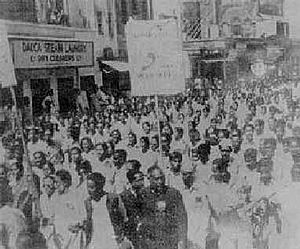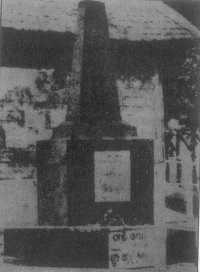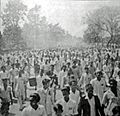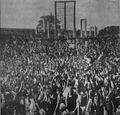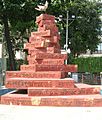Bengali Language Movement facts for kids
The Bengali Language Movement was a series of protests in Bangladesh. At that time, Bangladesh was known as East Pakistan and was part of Pakistan. People in East Pakistan spoke Bengali, but the government of Pakistan wanted to make Urdu the only official language. This meant Urdu would be used for all government business, schools, and public life.
The Bengali-speaking people did not agree with this decision. They wanted Bengali to be an official language too. They started protesting to protect their language. The government tried to stop the protests by banning public gatherings.
On 21 February 1952, a large protest took place in Dhaka. Police opened fire on the students who were protesting peacefully. Several students were killed. This event made the movement even stronger. To remember these brave students, a special monument called the Shaheed Minar was built.
Because of the movement, Bengali finally became an official language of Pakistan on 29 February 1956. Today, Bangladesh celebrates Language Movement Day every year on February 21st to honor those who fought for their language. This day is also recognized worldwide as International Mother Language Day.
Contents
Why the Language Movement Started
After British India gained independence in 1947, it was divided into two new countries: India and Pakistan. Pakistan was made up of two main parts: West Pakistan and East Pakistan (which is now Bangladesh). These two parts were separated by over 1,000 miles of Indian territory.
Most people in West Pakistan spoke Urdu, while most people in East Pakistan spoke Bengali. Even though East Pakistan had more people, the government, which was based in West Pakistan, decided that Urdu would be the only official language for the whole country. This decision made many people in East Pakistan feel like their language and culture were not respected.
Key Events of the Movement
Early Protests
The idea of making Urdu the only official language started even before Pakistan was fully independent. Students and cultural groups in East Pakistan began to protest this idea as early as 1947. They formed groups like the "Tamaddun Majlish" to speak out for Bengali.
In 1948, Muhammad Ali Jinnah, who was the first leader of Pakistan, visited Dhaka. He announced that Urdu would be the only state language. This made students and people in East Pakistan very upset, and more protests followed.
The Tragic Day of February 21, 1952
By 1952, the protests grew larger. On February 21, students in Dhaka organized a big march. The government had banned all public meetings, but the students decided to protest anyway.
When the students tried to march towards the provincial assembly building, police blocked them. Police used tear gas and then started shooting at the unarmed students. Several students, including Abul Barkat, Rafiq Uddin Ahmed, Abdus Salam, and Abdul Jabbar, were killed. This tragic event shocked the entire region and fueled the movement even more.
Building the Shaheed Minar
Right after the killings, people quickly built a small monument to honor the fallen students. However, the police destroyed it a few days later. But the spirit of the movement did not die.
Later, a much larger and more permanent monument, the Shaheed Minar, was built in Dhaka. It stands tall today as a symbol of the sacrifices made for the Bengali language. Many other smaller monuments have been built around the world to remember this day.
Impact and Legacy
The Bengali Language Movement was a very important event in the history of Bangladesh. It showed the world how much people cared about their language and cultural identity.
The movement helped to unite the people of East Pakistan. It also played a big role in the eventual creation of independent Bangladesh in 1971. The struggle for language rights became a key part of their fight for freedom.
Today, February 21st is celebrated as International Mother Language Day by UNESCO (the United Nations Educational, Scientific and Cultural Organization). This means that people all over the world celebrate the importance of all languages and cultures on this day, thanks to the sacrifices made in Bangladesh.
Images for kids
-
Britain's holdings on the Indian subcontinent were granted independence in 1947 and 1948, becoming four new independent states: the Dominion of India, the Union of Burma (now Myanmar), Dominion of Ceylon (now Sri Lanka), and the Dominion of Pakistan (including East Bengal, from 1956 East Pakistan, 1971-today Bangladesh).
-
Muhammad Ali Jinnah on 21 March 1948 told at a public meeting that State language of Pakistan is going to be Urdu and no other language.
-
Moder Gorob, a commemorative sculpture at Bangla Academy, Dhaka
-
International Mother Language Day Monument in Ashfield Park, Sydney
-
Bhasha Smritistambha in Kolkata
-
Mother Language Day Monument in Kolkata
-
The Shaheed Minar replica in Altab Ali Park, London
See also
 In Spanish: Movimiento por la Lengua Bengalí para niños
In Spanish: Movimiento por la Lengua Bengalí para niños


